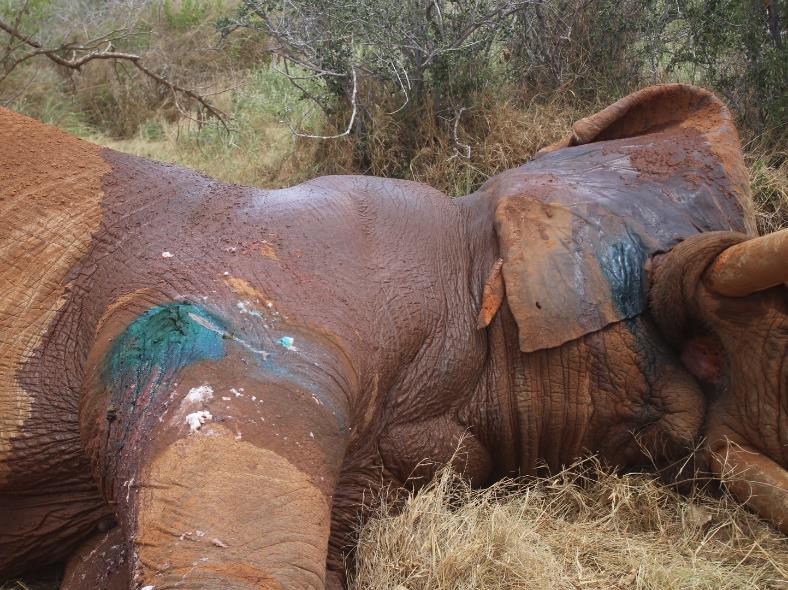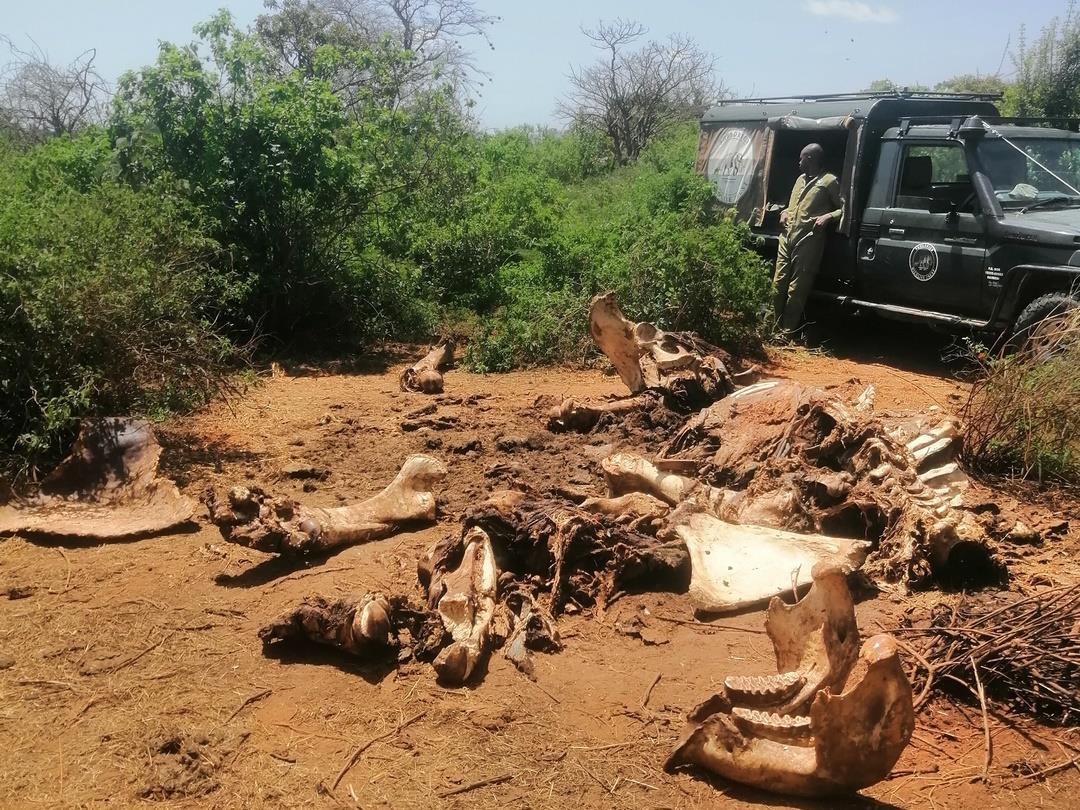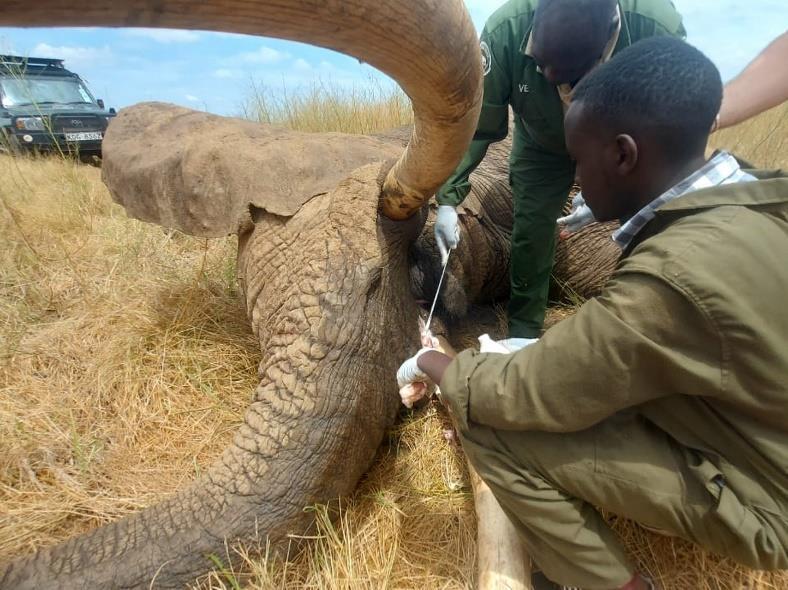
SWT/KWS TSAVO MOBILE VETERINARY UNIT
FEBRUARY 2024



February Report by Dr. Campaign Limo


The conservation area experienced decrease in precipitation compared the last two months of the previous year. The water pans are still full. Both grazers and browsers have plenty of food. The Tsavo Mobile Veterinary Unit (TMVU) was able to timely attend to all cases reported during this period.
Acknowledgement
e TMVU would like to thank all the stakeholders who helped report and monitor wildlife cases requiring their attention.
Thanks to KWS and SWT management for continuous support and facilitation to the unit.
Case Details
February 2024

Elephant Natural Causes Manda Rock, Tsavo East NP
The young bull was seen limping by SWT/KWS de-snaring team with a wound on his left hind foot. TMVU was notified and responded immediately.
Immobilisation, examination and treatment
The bull was immobilized using 16mg of Etorphine hydrochloride delivered remotely through a 3cc daninject dart. He was darted from a vehicle with the drugs taking full effect after seven minutes.
Examination revealed extensive ulceration on the lateral surface of his left foot. This was a newly ulcerated fibroma. The wound was cleaned with copious amount of water and the devitalized tissues removed. The ulceration was there after flushed using tincture of iodine solution. A topical antibiotic spray was then applied on the wound.
Additionally, this elephant was given antibiotics and anti-inflammatories parenterally before being reversed. Prognosis
The bull rose with ease and slowly walked away 2 minutes later and prognosis for full recovery is good.

Elephant Natural Causes Voi Gate, Tsavo East NP
This elephant cow was spotted by the visitors to the park with a non-weight bearing lameness on her right hind limb and was struggling to ambulate.
Immobilisation and examination
She was immobilized using 15mg of Etorphine in a 1.5cc dan-inject dart delivered remotely through the daninject darting system. Darting was done from foot. She was unable to move even after being darted with the drugs taking 7 minutes to achieve its full effect.
On examination her right hind foot had an open fracture of the tibia and fibula. There was extensive tissue necrosis and oedema on the affected limb.
Prognosis
Considering the extent of her injuries, grave prognosis, and her welfare the team saw it wise to euthanize her to alleviate her from pain and suffering. She was immediately humanely put down.

Elephant Natural Causes Oldonyo Lodge, Chyulu Hills
This huge bull with a swelling on his ventral surface of the neck was spotted at a watering point by the BIG LIFE staff.


Immobilisation, examination and treatment
The bull was successfully anaesthetized by use of 20mg of Etorphine hydrochloride delivered in a 3cc daninject dart. Darting was done from the vehicle. Full anaesthesia was achieved after ten minutes.
Examination revealed he had a firm swelling on the ventral neck area and on aspiration the swelling was confirmed to be an abscess. The abscess was incised using a blade and drained of its contents. All devitalized tissues within the capsule were removed with clean water and infused with Hydrogen peroxide to break down the pyogenic membrane. Iodine was infused into the wound. A topical antibiotic spray was applied at the point of incision. He was also given antibiotics and anti-inflammatory drugs parenterally.
Prognosis


Elephant Spear Oldonyo Lodge, Chyulu Hills
The Sheldrick wildlife trust keepers at the Ithumba stockade spotted an ex-orphan at the vicinity of the stockade who seemed to have suffered a puncture wound to his left shoulder area and his ear. The Sheldrick wildlife trust airlifted the TMVU team to Ithumba to attend to this elephant.
Immobilisation, examination and treatment
The bull was immobilized using 13mg of Etorphine in a 1.5cc dan-inject dart delivered remotely from foot, it took 9 minutes for the drug to take full effect.
Examination revealed he had suffered a deep puncture (approximately 10cm) wound that went through the pinnae of the ear into the shoulder area. The wound was suspected to have been caused by a spear. The wound was septic, with purulent discharge. Pus and necrotized tissues within the wound were removed, the wound was then flushed with Hydrogen peroxide, washed with clean water and infused with tincture of Iodine solution. The wound was then packed with green clay. The bull was then given antibiotics and antiinflammatories parenterally before reversal.
Prognosis
Good.




Elephant Spear Tsavo East National Park
The elephant bull was spotted by visitors to the park around Buchuma area, limping with a wound on his proximal fore limb oozing pus. The sighting of the bull was reported to the Tsavo mobile veterinary unit who responded immediately.


Immobilisation, examination and treatment
The bull was immobilized using 20 mg of etorphine hydrochloride in a 3cc dan-inject dart. He was darted from a vehicle, and it took 8 minutes for the drug to achieve its full effect.
On examination the bull had a puncture wound that was approximately 15cm deep. This was suspected to be a spear wound. The wound was cleaned of pus and all devitalized tissues removed, it was thereafter flushed with Hydrogen peroxide and infused with Iodine solution after rinsing it with copious amount of clean water. Antibiotic pessaries were introduced deep in the wound. Finally green clay was packed on the wound. He was thereafter given antibiotics and anti-inflammatories parenterally.
Prognosis
Favourable The teams on the ground were advised to monitor this bull and report his progress.


Elephant Natural Causes Kulalu Ranch
The elephant bull was spotted by the Sheldrick wildlife trust plane while on routine patrols around the conservation area. It was noted that he had a swelling on his face and was also reluctant to move. The Tsavo vet unit was notified and were airlifted to the area.
Immobilisation, examination and treatment
The team decided to immobilize the elephant for closer examination and possible treatment.
The bull was immobilized using 20mg of Etorphine hydrochloride in a 3cc dan-inject dart. He was darted from the helicopter and was deep under anaesthesia 8 minutes later.
Examination revealed that the swelling was fibrous tissue that had formed as part of wound healing process. No other injuries were observed. The bull received antibiotics, anti-inflammatories, and metabolic stimulants parenterally.
Prognosis
The bull was revived using 250mg Naltrexone hydrochloride given intravenously via a prominent ear vein. He rose and walked away 3 minutes later with a good prognosis.

Elephant Post-mortem Tsavo West NP
The elephant carcass was spotted during routine air patrols by KWS pilot. The tusks were still intact.
TMVU was notified to carry out examination and establish the possible cause of death.
Examination
Both tusks were intact and had been taken for safe custody by the KWS rangers.
The carcass had been stripped to the bone by scavengers and had fully decomposed.
The carcass was estimated to be more than a month old.
Cause of Death
The cause of death remained unknown due to advanced decomposition and scavenging.

Lion Human – Wildlife Conflict Manyani, Tsavo
The young lioness was spotted within the SGR fenced area, weak and unable to get herself out through the electric fence. Her mother was seen patrolling the fence from outside.
Immobilisation, examination and treatment
She was immobilized using a combination of 4mg Medetomidine and 200mg Ketamine, Darting was done from the SGR maintenance train. She was deep under anaesthesia 8 minutes later.
She was moved to a shade away from the enclosed area. Examination revealed a lioness who was extremely dehydrated and in poor body condition. She had probably gone for almost a week without food or water. She was immediately put under aggressive fluid therapy to replace fluids and thereafter given antiinflammatories, antibiotics and metabolic stimulants.
Relocation
After around an hour she was revived using 20mg atipamezole Hydrochloride given intramuscularly. She was awake and alert 3 minutes later but remained at the same position. She got supplemental feeding before leaving to join her pride later at night. Prognosis is guarded.

Elephant Spear Tsavo East NP
The elephant bull was spotted by the Sheldrick wildlife trust pilot during routine air patrol with a wound on his left rump. The Tsavo Vet Unit was notified and airlifted to the area to examine and treat this elephant.
Immobilisation, examination and treatment
The bull was immobilized using 20mg of Etorphine hydrochloride delivered remotely in a 3cc dan-inject dart. Darting was done from the helicopter. He was fully anesthetized 9 minutes later.
Examination revealed a deep pus-filled wound (suspected to be a spear wound) at the left rump area. The wound was thoroughly cleaned of pus and devitalized tissues removed. It was thereafter flushed with Hydrogen peroxide, rinsed with clean water and infused with tincture of Iodine. The deep wound was then packed with antibiotic pessaries and applied with topical antibiotic spray.
He was given anti-inflamatories (flunixin meglumine), antibiotics (amoxicillin) both parenterally.
Prognosis
He was revived using 200 mg of Naltrexone hydrochloride given intravenously through an ear vein, he was up and going 3 minutes later with a good prognosis.


Cheetah Human-Wildlife Conflict Kuranze Ranch, Taita
The injured cheetah was spotted by KWS and Wildlife works rangers along one of the access roads of the ranch, unable to move
Immobilisation, examination and treatment
The cheetah was immobilized using a combination of 1.5mg Medetomidine and 120mg Ketamine injected directly intramuscularly. It took 6 minutes for the drugs to achieve full effect.
Examination revealed a completely fractured lumbar vertebrae. This ultimately led to paralysis of the hind limbs and the tail. This was suspected to be as a result of being hit by a fast-moving vehicle.
Due to her grave prognosis and extreme pain, the team decided to euthanize her on animal welfare grounds. She was put down humanely by rapid intravenous injection of sodium pentobarbitone.
Post-mortem
Postmortem examination confirmed the clinical diagnosis. Her spine at mid- lumbar vertebrae was completely fractured with extensive haemorrhage and congestion of tissues around the fracture site.

Elephant Spear Tsavo East NP
An injured elephant bull was spotted in Kishushe area by SWT pilot on patrol in collaboration with KWS/SWT rangers who were at this location. He had a wound on his right flank area.
Immobilisation, examination and treatment
He was immobilized using 20mg of Etorphine remotely delivered in a 3cc dan-inject dart from the helicopter. It took 9 minutes for the drug to achieve its full effects.
Examination revealed a deep spear wound on his right flank; the wound was oozing pus. He also had 2 other wounds on the ventral area on the base of his trunk. All three wounds were thoroughly cleaned with clean water Pus and devitalized tissues were removed, this was followed by flushing the wound with Hydrogen peroxide. The wound was then washed with clean water dried using swabs and infused with tincture of iodine solution. Topical antibiotic spray was applied on all the wounds. The deep spear wound in the flank was packed with antibiotic pessaries. He was then given antibiotics and anti-inflamatories parenterally
Prognosis
He was revived using 200mg of Naltrexone hydrochloride given intravenously through an ear vein. He was up and going 3 minutes later with a good prognosis.

Elephant Arrow Tsavo East NP
The elephant bull was spotted Sheldrick air patrol pilot. He had a swelling on his rump area.
Immobilisation, examination and treatment
He was anaesthetized using 20 mg of etorphine hydrochloride delivered on a 3cc daninject dart. Darting was done from the helicopter. It took 8 minutes for the drug to achieve its full effect.
Examination revealed a firm swelling on right side of the rump with pus oozing from a small opening on the swelling. The opening was extended to evacuate the contents of the abscess. The abscess was then flushed using hydrogen peroxide, washed with clean water, dried with swabs and infused with tincture iodine solution.
Antibiotic pessaries were packed into the wound and topical antibiotic spray applied. He was also given antibiotics (amoxicillin) and anti-inflammatories (flunixin meglumine) parenterally.
Prognosis
He was reversed from the anaesthesia using 200mg of Naltrexone hydrochloride. He woke up three minutes after reversal to join the rest of the bull herd a few meters away.

Elephant Natural Causes Tsavo East National Park
This big elephant bull was spotted by the Sheldrick wildlife air patrol team with a swelling on his left flank area. TMVU was notified and responded immediately.


Immobilisation, examination and treatment
He was darted from a vehicle with 20mg Etorphine and It took 9 minutes for the drug to achieve its full effect.
Examination revealed a firm swelling on the flank area. Aspiration of its content ruled out an abscess. The swelling was as a result of excessive fibrous tissue formation during the healing process of an earlier injury. Another wound was also seen at the ventral surface of his trunk close to the mouth. This was beginning to be septic. It was suspected to be a fight wound with other bulls. The wound was cleaned with copious amount of water and flushed with Hydrogen peroxide and dried using gauze swabs. Tincture of Iodine solution was then infused into the wound followed by application of topical antibiotic spray. He was given antibiotics (amoxicillin) and anti-inflamatories (flunixin) parenterally.
Prognosis
Prognosis is good.


